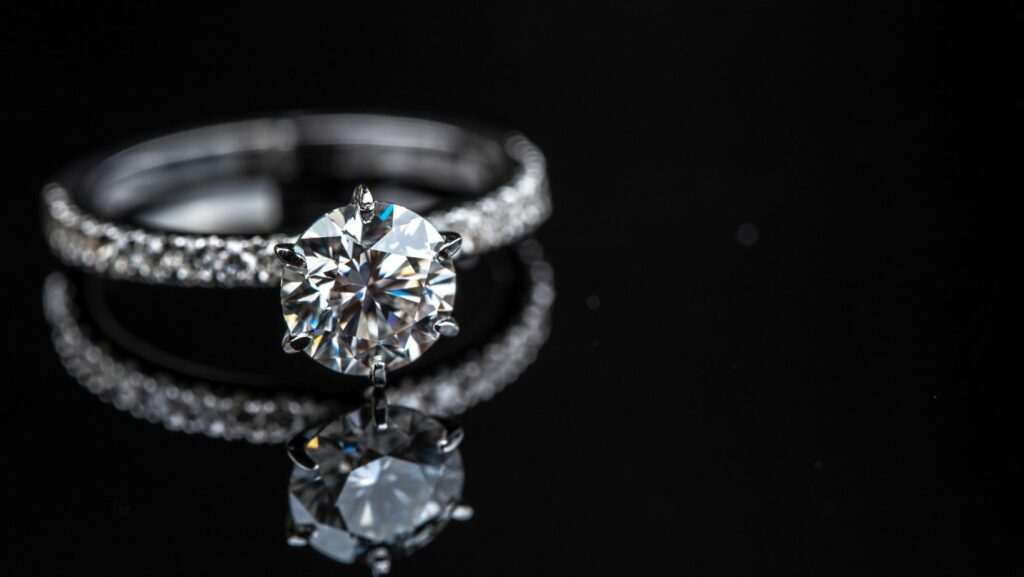Choosing an engagement ring is one of the most meaningful decisions a couple makes, as the gemstone selected often carries deep symbolic significance that will be cherished for a lifetime. But what are the symbolic meanings behind different gemstones in engagement rings?
Each traditional engagement ring gemstone carries unique symbolism: diamonds represent eternal love and purity, sapphires symbolize loyalty and wisdom, rubies represent passion and vitality, and emeralds signify hope and new beginnings.
While this quick overview covers the most common gemstones, there are actually dozens more options available for engagement rings, each with its own fascinating symbolic meanings that could perfectly represent your unique relationship. Understanding the full spectrum of gemstone symbolism can help you choose a ring that truly tells your love story.
Here Are The Symbolic Meanings Of Additional Popular Engagement Ring Gemstones
Pearl engagement rings symbolize purity and innocence, making them particularly meaningful for couples who value these qualities in their relationship. Opals represent hope, creativity, and faithfulness, though some consider them unlucky unless they’re your birthstone. Amethysts symbolize peace and emotional balance, while aquamarine represents courage and clear communication in marriage.

Morganite, a relatively newer engagement ring choice, carries divine love and healing meanings. Rose quartz, known as the stone of universal love, promotes harmony in relationships. Tanzanite represents transformation and spiritual awareness, perfect for couples embarking on their life journey together.
When planning a proposal, many couples search for the best engagement rings Melbourne has to offer, combining quality craftsmanship with timeless design
What Do Different Colored Diamonds Symbolize In Engagement Rings?
While clear diamonds are classic, colored diamonds carry their unique symbolism. Yellow diamonds represent joy, optimism, and new beginnings. Pink diamonds symbolize creativity, romance, and artistic expression. Blue diamonds represent loyalty, destiny, and spirituality, while black diamonds symbolize power, strength, and passion.
Brown diamonds, often called champagne diamonds, represent stability and pragmatism. Green diamonds, among the rarest, symbolize nature, growth, and prosperity. Red diamonds, the rarest of all, represent intense love and courage.
How Can You Combine Multiple Gemstones To Create Meaningful Symbolism?
Many couples combine different gemstones in their engagement rings to create layered meaning. A popular combination is a diamond center stone surrounded by sapphire accents, representing eternal love protected by loyalty and wisdom. Another meaningful pairing is an emerald with diamond side stones, symbolizing hope and new beginnings encompassed by enduring love.
Some couples incorporate their birthstones alongside traditional engagement ring gems, adding a personal touch to the ring’s symbolism. Others select stones based on their relationship anniversary months or significant dates, creating a truly unique piece that tells their specific love story.
What Role Do Birthstones Play In Engagement Ring Symbolism?
Each month’s birthstone carries its symbolic meaning that can add personal significance to an engagement ring. January’s garnet represents eternal friendship and trust, while February’s amethyst promotes serenity in relationships. March’s aquamarine brings youth and hope, and April’s diamond symbolizes innocence and everlasting love.

May’s emerald represents successful love, while June offers a choice between pearl, alexandrite, and moonstone, each representing purity and emotional balance differently. July’s ruby symbolizes passion, August’s peridot brings prosperity, and September’s sapphire represents loyalty. October’s opal or tourmaline promotes hope and healing, November’s topaz or citrine represents strength, and December’s turquoise or tanzanite brings good fortune and protection.
How Does The Cultural Background Of Different Gemstones Affect Their Symbolism?
Different cultures throughout history have assigned varying meanings to gemstones, which can add more profound significance to an engagement ring choice. In Indian culture, rubies are considered the king of gemstones and represent the sun and powerful love. Chinese tradition values jade above all other stones, seeing it as a symbol of virtue, purity, and good fortune.
Middle Eastern cultures have long valued sapphires as symbols of heaven and divine blessing, while ancient Greeks believed amethysts could prevent intoxication and promote clear thinking in relationships. Native American traditions often incorporate turquoise as a symbol of protection and connection to the earth. Understanding these cultural meanings can help couples choose stones that reflect their heritage or spiritual beliefs in their engagement rings.
Some couples even blend cultural symbolism in their rings, creating pieces that represent the joining of different backgrounds and traditions. This thoughtful approach to selecting gemstones can make an engagement ring not just a symbol of love but also a celebration of cultural identity and shared values.
Choosing Your Gemstone
When selecting your engagement ring gemstone, reflect on which symbolic meanings resonate most deeply with your relationship’s unique story and values. Consider discussing these meanings with your partner, as choosing a stone that carries significance for both of you will make the ring even more meaningful as a symbol of your commitment to each other.

